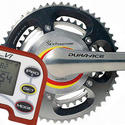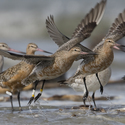You can tell a great deal about how a bird lives or what a plane has been designed for just from its wing shape and size. Wings of both birds and planes determine how they might perform or what they might be capable of (for example, gliding, sustained high speed or manoeuvrability). One way in which the size of the wing can be described is through wing loading.
Wing loading
Wing loading is a measurement that relates the mass of an aircraft or bird to the total wing area. The relationship between wing area and body weight is given in kilograms per square metre (or grams per square centimetre).
To calculate wing loading, divide the mass of the bird or plane by the total area of the upper surface of its wings: wing loading = body mass (kg)/wing area (m2).
If a bird or plane has a low mass but has rather large wings, it will have low wing loading, for example, gliders have low mass with large wings and therefore have low wing loading.
A bird or plane with large body mass and small wings consequently has high or heavy wing loading. An Airbus A380 has a large mass with comparatively small wings. It has heavy wing loading.
Wings generate lift due to the flow of air over the wing surface. Larger wings move more air, so a bird or plane with a large wing area relative to its mass (low wing loading) will have more lift at any given speed. Therefore, a plane with lower wing loading will be able to take off and land at a lower speed (or be able to take off with a greater load). It will also be able to turn faster.
Wing loading for birds is generally between 1 to 20 kg/m2. The maximum possible wing load before a bird is unable to fly is about 25 kg/m2. This is when the bird is too heavy for its wings (like the kiwi, which has tiny wings and a large body mass). The wing loadings of some of the lightest planes fall within the bird range. A typical hang-glider may have a maximum wing loading of 6.3 kg/m2. On the heavy side, a Boeing 747 has a maximum wing loading of about 730 kg/m2. Although it has a huge wing load, it can fly because of its incredible speed.
Different wing shapes and sizes correspond to different flight capabilities. Two ways in which wing size and shape can be described are through wing aspect ratio and wing loading.
Wing size and speed
If an elephant (which has a large heart and strong muscles) had wings, could it fly? It couldn’t fly, because it’s too heavy. A bat has wings and can fly – for every gram of the bat, there is 5 cm2 of wing area. If you apply this to an elephant of mass 3500 kg, you need a wing area of 1750 m2, which is more than the total area of 6 tennis courts! Even if the elephant had enormous wings, they would have to be supported by strong bones, and the weight of these would increase the wing loading. They would also need strong muscles to move the wings, which would also add to the wing loading.
Planes are heavy (like the elephant), but they can move very fast, showing that the ability to fly depends not only on wing size but also on the speed at which the wings move through the air. A plane will leave the runway because the speed at which it travels (for example, 280 kph for an Airbus A380) allows the wings to develop lift great enough to raise the heavy machine into the air. The faster a plane or bird flies, the more lift is produced by each unit area of wing. So planes and birds with smaller wings can carry the same heavy load as larger winged planes and birds if they travel faster.
How do birds fly? Birds have many features, besides wings, that work together to enable them to fly. The four forces of flight – weight, lift, drag and thrust – affect the flight of birds.
Activity ideas
Continue the learning with your students with one or more of these activities
- Aerofoils and paper planes – learn how to make an aerofoil and to make and fly paper planes.
- Making a glider – handcraft a glider from balsa wood and in the process learn about aerofoil wing shape, glider parts and terminology. Then experiment with flight using variables of wind and nose weight.
- Kites – learn about some kite history and how kites fly before making and flying a kite.
- Birds and planes – explore the importance of wing shape and size and how this determines the flight capabilities of birds and planes.
- Observing wings for flight has suggestions on how to use the interactive Wings for flight graphic organiser. Wings for flight is useful as a pre-test or post-test for summative assessment.




















